The Next-Generation Sensor for the Smart Home, Connected Office, and Personal Wellness
Recently, advances in radar research have made it possible to bring this technology into the home, office, hospital, and even car.
March 21, 2023

Sponsored Content
By Edmund Neo, Director, Product Marketing, Infineon
Originally invented in 1935, radar was used during WWII as part of British air defense to save lives. Recently, advances in radar research have made it possible to bring this technology into the home, office, hospital, and even car. Combined with today’s high-speed, highly integrated, and feature-rich microcontroller units (MCUs), cost-effective radar is available for a new generation of exciting applications.
Radar vs PIR
Passive infrared (PIR) is a commonly used range sensor offering a good field of view (FOV) and low power operation. However, it has several limitations that increase cost and reduce its usefulness. For example, a PIR-based sensor requires a lens to focus light through, increasing sensor size and manufacturing complexity. Infrared also cannot see through walls or objects.
One of the primary limitations of a PIR sensor is that it requires exaggerated motion to trigger. For example, a person scrolling on his or her phone will not be detected. Thus, a PIR-base sensor used to control lights may turn the lights off if a person in the room is engaged in a quiet activity, like scrolling or reading and not moving. Additionally, PIR sensors do not detect velocity, so they can’t distinguish between a person walking towards the sensor or away from it.
Radar has much greater sensitivity than PIR and other motion sensing technologies. Radar can also sense distance, velocity, and angle. With this information, radar can infer the difference between a person, animal, robot, or even an object moving in the wind. Radar, with continuing advances in machine learning, is also able to recognize gestures with a high degree of accuracy. Because radar can detect even the smallest motion, including vital signs, a person who is not actively moving can still be sensed. Thus, a radar-based sensor can accurately sense ‘presence’ so that lights will never be turned OFF when someone is in the room, no matter what they are doing.
As radar waves penetrate all non-conductive materials, it is also possible to sense through industrial design materials, such as plastic. This means that besides providing “attractive” industrial design possibilities, radar can also sense objects behind a blanket, a piece of furniture, and even walls in the home or office, which has several major benefits.
For example, with PIR, the product must be designed around the sensor and lens so that the lens is unobstructed. As a result, users will be able to see the lens, limiting the product’s final design, shape, and appeal. Because radar can see through materials, radar-based sensors can be hidden in the end product, allowing product design flexibility and for users to be more at ease.
Radar is also environmentally resilient. Radar works in sun, dark, and all other lighting conditions. It is robust to fog, dust, and temperature as well. Furthermore, radar sensors do not require maintenance like other sensors do, significantly reducing operational costs.
Radar and Wellness
Radar is actually sensitive enough to recognize a person’s chest movement during respiration and can be used to monitor vital signs (see Figure 1). For example, radar is currently utilized in a contactless sleep monitoring device to track personal wellness, including to aid with sleep apnea. Using software to process the radar signal, a person’s breath rate and heart rate can be accurately tracked. As a contactless solution, radar can be used to monitor the well-being of babies and children as they sleep.
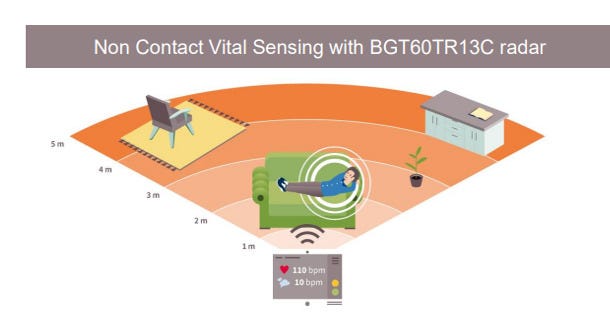
Figure 1: Radar technology can be used to actively detect if an elder has fallen and confirm their vitals to determine if help needs to be sent without the elder having to be conscious or able to press an alert button.
Radar is also being used in a variety of safety applications. By detecting presence in a vehicle, the car can alert a driver if they have left a child or pet behind when they leave. Radar has also increased safety in elder care situations, such as tracking a person to make sure they are active without requiring cameras that compromise their privacy. The same technology can be used to actively detect if an elder has fallen and confirm their vitals to determine if help needs to be sent without the elder having to be conscious or able to press an alert button.
Radar in the Smart Home and Connected Office
Today, radar is already in the home and office to improve the user experience. Radar-enabled thermostats can be activated by user proximity and support gesture control. When combined with a security camera, the camera activates only when the radar sensor detects presence (i.e., both someone moving or standing still) inside the area of coverage. This results in greater accuracy by reducing the number of false alarms.
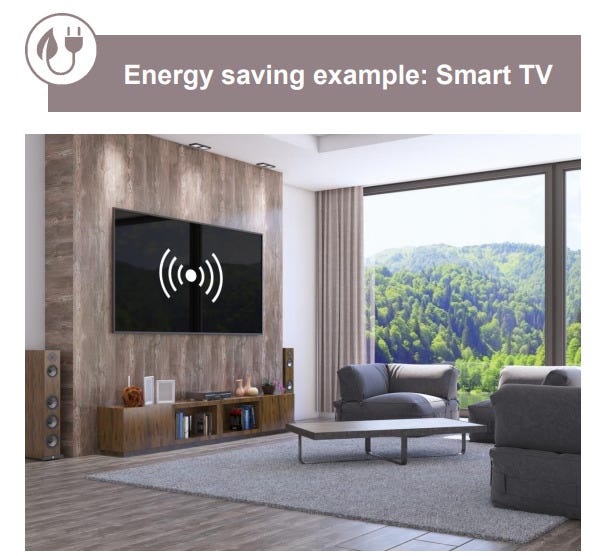
Figure 2: For power savings, radar can accurately track where people are located to optimize activating devices like the Samsung Frame TV model 2020 (shown) or putting them back to sleep.
For power savings, including smart lighting, TVs, and even laptops, radar can accurately track where people are located to optimize activating devices or putting them back to sleep (see Figure 2). With the ability to see through walls, radar-based sensors can turn lights on when a person approaches a room, rather than forcing them to stand in the doorway waiting for the lights to activate. With location tracking, presence and vacancy detection can be enhanced to control the environment based on where people are actually located. For example, airflow from the A/C could be directed away from where people are sitting. And a home network of radar-enabled devices could provide everything from passive lighting control to gesture control of devices throughout the smart network to advanced elder care capabilities.
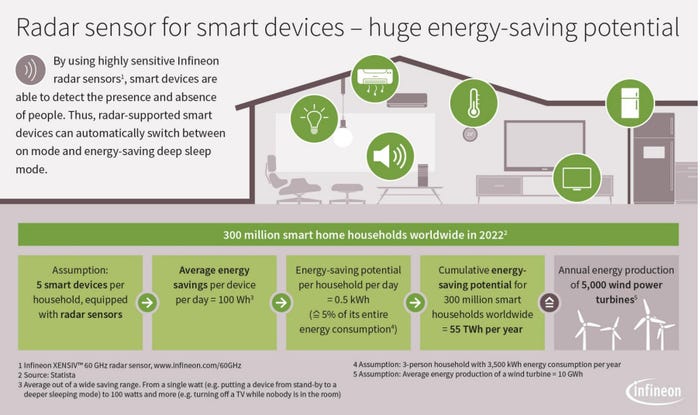
Figure 3: The potential power savings of controlling consumer electronics through presence sensors like radar is tremendous.
The potential power savings of consumer electronics through smart control is tremendous. For example, assume the average smart house has 5 devices controlled with radar sensors, leading to 100 Wh saved per device per day by turning off lights and TVs when they are not actively being used. This leads to a potential savings of 0.5 kWh per day, or ~5% of the entire household energy consumption. Put in terms of 300 million smart homes worldwide, the savings would be ~55 TWh per year (see Figure 3).
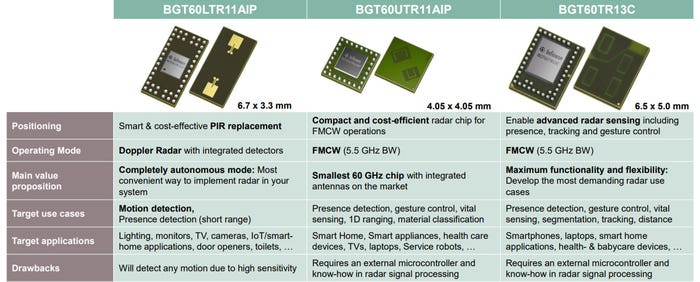
Figure 4: To assist OEMs in developing next-generation radar-enabled devices, Infineon’s XENSIV line of 60 GHz and 24 GHz radar sensors offer a variety of transmit and receive combinations, many with Antenna-in-Package (AIP), to meet the needs of different applications.
To assist OEMs in developing next-generation radar-enabled devices, Infineon has created the XENSIVTM product line of 60 GHz and 24 GHz radar sensors (see Figure 4). These sensors offer a variety of transmit and receive combinations to meet the needs of different applications. Many of these offerings have Antenna-in-Package (AIP), greatly simplifying design and manufacturing. With the BGT60TR13C, even the most advanced smart device sensing applications become possible (see Figure 5). All XENSIVTM radar products are supported by development kits, advanced software tools, and compatible with Infineon PSoCsTM MCUs.
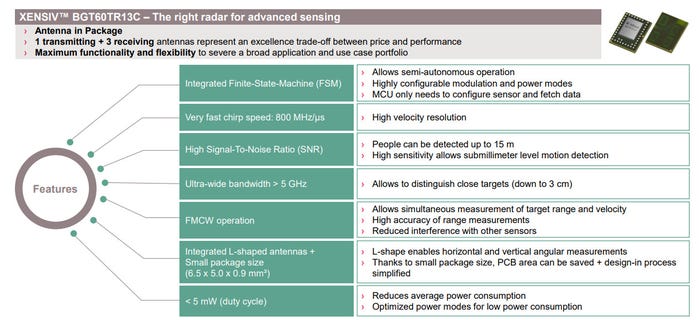
Figure 5: With the BGT60TR13C radar sensor from Infineon, even the most advanced sensing smart device applications become possible.
Infineon is excited about the possibilities for radar within the home, office, car and for wellness. With contactless interaction and greater sensitivity, radar ensures a better user experience without intruding on privacy. Working together with our partners, we look forward to enabling innovative and intuitive sensing capabilities to more applications.
To learn more about how radar can provide next-generation sensing capabilities for your smart applications, visit Infineon.com/sensors.
You May Also Like






